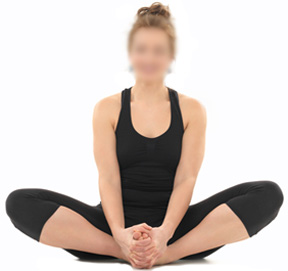
Posture:Baddha-kona-asana-The Restrained Angle Pose
Translation:The Sanskrit word baddha means a bond, chain, caught or restrained. The word pada means foot, and kona means corner
Pronunciation:ba-dah-cone-ah-sa-na
Difficulty:(4)
Instructions:
- Sit on the floor with the legs together and extended straight out in front. Keep the back straight, shoulders level and head straight. Place the hands, palms down, flat on top of the thighs then inhale deeply.
- Exhale and bend the knees drawing the feet toward the torso.
- Place the soles of the feet together, clasp the hands over the feet interlocking the fingers pulling the feet closer and placing the heels against the perineum. The outer edge and small toe of each foot should touch the floor.
- Lower the knees to the floor and keep the back straight. Use the elbows to press down on the thighs if necessary to bring the calves and knees to the floor. Hold the posture breathing gently through the nostrils.
- Release the posture and sit with the legs extended out and hands on the thighs
Comments:
Regular practice of the baddhakona-asana stretches the knees and stimulates circulation in the legs. It should be practiced frequently until one is comfortable sitting in the padma-asana. The main areas of the body that are stimulated, besides the legs, are the stomach, pelvis and lower back. It is said to keep the kidneys, prostate and bladder healthy. The baddha-konasana is one of the few postures that can be practiced comfortably soon after eating.
Duration/Repetitions:
Hold the posture from thirty seconds to two minutes depending on comfort. Repeat two or three times.


